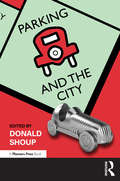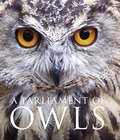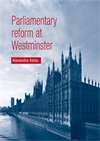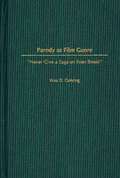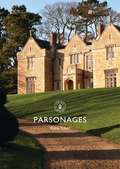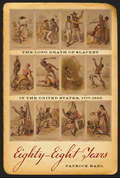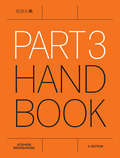- Table View
- List View
Parking and the City
by Donald ShoupDonald Shoup brilliantly overcame the challenge of writing about parking without being boring in his iconoclastic 800-page book The High Cost of Free Parking. Easy to read and often entertaining, the book showed that city parking policies subsidize cars, encourage sprawl, degrade urban design, prohibit walkability, damage the economy, raise housing costs, and penalize people who cannot afford or choose not to own a car. Using careful analysis and creative thinking, Shoup recommended three parking reforms: (1) remove off-street parking requirements, (2) charge the right prices for on-street parking, and (3) spend the meter revenue to improve public services on the metered streets. Parking and the City reports on the progress that cities have made in adopting these three reforms. The successful outcomes provide convincing evidence that Shoup’s policy proposals are not theoretical and idealistic but instead are practical and realistic. The good news about our decades of bad planning for parking is that the damage we have done will be far cheaper to repair than to ignore. The 51 chapters by 46 authors in Parking and the City show how reforming our misguided and wrongheaded parking policies can do a world of good. Read more about parking benefit districts with a free download of Chapter 51 by copying the link below into your browser. https://www.routledge.com/posts/13972
Parking and the City
by Donald ShoupDonald Shoup brilliantly overcame the challenge of writing about parking without being boring in his iconoclastic 800-page book The High Cost of Free Parking. Easy to read and often entertaining, the book showed that city parking policies subsidize cars, encourage sprawl, degrade urban design, prohibit walkability, damage the economy, raise housing costs, and penalize people who cannot afford or choose not to own a car. Using careful analysis and creative thinking, Shoup recommended three parking reforms: (1) remove off-street parking requirements, (2) charge the right prices for on-street parking, and (3) spend the meter revenue to improve public services on the metered streets. Parking and the City reports on the progress that cities have made in adopting these three reforms. The successful outcomes provide convincing evidence that Shoup’s policy proposals are not theoretical and idealistic but instead are practical and realistic. The good news about our decades of bad planning for parking is that the damage we have done will be far cheaper to repair than to ignore. The 51 chapters by 46 authors in Parking and the City show how reforming our misguided and wrongheaded parking policies can do a world of good. Read more about parking benefit districts with a free download of Chapter 51 by copying the link below into your browser. https://www.routledge.com/posts/13972
Parking Management Best Practices
by Todd LitmanThis book is a blueprint for developing an integrated parking plan. It explains how to determine parking supply and affect parking demand, as well as how to calculate parking facility costs. It also offers information about shared parking, parking maximums, financial incentives, tax reform, pricing methods, and other management techniques. What types of locations benefit from parking management? Places with perceived parking problems. Areas with rapidly expanding population, business activity, or traffic. Commercial districts and other places with compact land-use patterns. Urban areas in need of redevelopment and infill. Places with high levels of walking or public transit or places that want to encourage those modes. Districts where parking problems hinder economic development. Areas with high land values Neighborhoods concerned with equity, including fairness to nondrivers. Places with environmental concerns. Unique landscapes or historic districts in need of preservation,"
Parking Management Best Practices
by Todd LitmanThis book is a blueprint for developing an integrated parking plan. It explains how to determine parking supply and affect parking demand, as well as how to calculate parking facility costs. It also offers information about shared parking, parking maximums, financial incentives, tax reform, pricing methods, and other management techniques. What types of locations benefit from parking management? Places with perceived parking problems. Areas with rapidly expanding population, business activity, or traffic. Commercial districts and other places with compact land-use patterns. Urban areas in need of redevelopment and infill. Places with high levels of walking or public transit or places that want to encourage those modes. Districts where parking problems hinder economic development. Areas with high land values Neighborhoods concerned with equity, including fairness to nondrivers. Places with environmental concerns. Unique landscapes or historic districts in need of preservation,"
PARKitectOUR: From Urban Free Flow to Architecture (RIEAeuropa Concepts Series)
by Guy Lafranchi Lebbeus WoodsPARKitectOUR, is a book which documents the three student workshops held in Italy and Switzerland by the University Of Applied Sciences of Bern. The task was to show Parkour and architecture within urban projects. Parkour is a new sport that was created in the suburbs of Paris. A ‘Traceur’ (the runner) moves smoothly, acrobatically and quickly through impenetrable, typically urban terrain. The Traceurs motion creates the "urban free flow." This urban free flow is what the students had to trace in their designs. This was completed along with urban planning tasks in the surroundings of a Luigi Nervi building in Turin. The workshop was organized in cooperation with the Politecnico di Torino. The other two workshops are part of the freshman curriculum at the university where Guy Lafranchi is the dean of studies of the architecture department.
A Parliament of Owls
by Mike UnwinA unique collection of stunning photographs and detailed portraits of over fifty of the most striking owl species around the world. Recommended for viewing on a colour tablet.
Parliamentary reform at Westminster: None
by Alexandra KelsoThe Labour government elected in 1997 pledged to reform the Westminster parliament by modernising the House of Commons and removing the hereditary peers from the House of Lords. Events have consequently demonstrated the deep controversy that accompanies such attempts at institutional reconfiguration, and have highlighted the shifting fault lines in executive-legislative relations in the UK, as well as the deep complexities surrounding British constitutional politics. The story of parliamentary reform is about the nature of the British political system, about how the government seeks to expand its control over parliament, and about how parliament discharges its duty to scrutinise the executive and hold it to account. This book, available in paperback for the first time, charts the course of Westminster reform since 1997, but does so by placing it in the context of parliamentary reform pursued in the past, and thus adopts a historical perspective which lends it considerable analytical value. Significantly, the book examines parliamentary reform through the lens of institutional theory, in order not only to describe reform but also to interpret and explain it. It also draws on extensive interviews conducted with MPs and peers involved in the reform of parliament since 1997, thus offering a unique insight into how these political actors perceived the reform process in which they played a part. Parliamentary reform at Westminster, now available in paperback, provides a comprehensive and authoritative analysis of the trajectory and outcome of the reform of parliament, along with an incisive interpretation of the implications for our understanding of British politics.
Parliamentary reform at Westminster (PDF)
by Alexandra KelsoThe Labour government elected in 1997 pledged to reform the Westminster parliament by modernising the House of Commons and removing the hereditary peers from the House of Lords. Events have consequently demonstrated the deep controversy that accompanies such attempts at institutional reconfiguration, and have highlighted the shifting fault-lines in executive–legislative relations in the UK, as well as the deep complexities surrounding British constitutional politics. The story of parliamentary reform is about the nature of the British political system, about how the government seeks to expand its control over parliament, and about how parliament discharges its duty to scrutinise the executive and hold it to account. This book charts the course of Westminster reform since 1997, but does so by placing it in the context of parliamentary reform pursued in the past, and thus adopts a historical perspective which lends it considerable analytical value. Significantly, the book examines parliamentary reform through the lens of institutional theory, in order not only to describe reform but also to interpret and explain it. It also draws on extensive interviews conducted with MPs and peers involved in the reform of parliament since 1997, thus offering a unique insight into how these political actors perceived the reform process in which they played a part. Parliamentary reform at Westminster provides a comprehensive and authoritative analysis of the trajectory and outcome of the reform of parliament, along with an incisive interpretation of the implications for our understanding of British politics.
Parody as Film Genre: Never Give a Saga an Even Break (Contributions to the Study of Popular Culture)
by Wes D. GehringParody is the least appreciated of all film comedy genres and receives little serious attention, even among film fans. This study elevates parody to mainstream significance. A historical overview places the genre in context, and a number of basic parody components, which better define the genre and celebrate its value, are examined. Parody is differentiated from satire, and the two parody types, traditional and reaffirmation, are explained. Chapters study the most spoofed genre in American parody history, the Western; pantheon members of American Film Comedy such as The Marx Brothers, W. C. Fields, Mae West, and Laurel and Hardy; pivotal parody artists, Bob Hope and Woody Allen; Mel Brooks, whose name is often synonymous with parody; and finally, parody in the 1990s. Films discussed include Destry Rides Again (1939), The Road to Utopia (1945), My Favorite Brunette (1947), The Paleface (1948), Butch Cassidy and the Sundance Kid (1969), Blazing Saddles (1974), Young Frankenstein (1974), Hot Shots! Part Deux (1993) and Scream (1996).This examination of parody will appeal to scholars and students of American film and film comedy, as well as those interested in the specific comedians discussed and the Western genre. Gehring's work will also find a place in American pop culture studies and sociological studies of the period from the 1920s to the 1990s. The book is carefully documented and includes a selected bibliography and filmography.
Parody, Politics and the Populace in Greek Old Comedy
by Donald SellsThis book argues that Old Comedy's parodic and non-parodic engagement with tragedy, satyr play, and contemporary lyric is geared to enhancing its own status as the preeminent discourse on Athenian art, politics and society. Donald Sells locates the enduring significance of parody in the specific cultural, social and political subtexts that often frame Old Comedy's bold experiments with other genres and drive its rapid evolution in the late fifth century. Close analysis of verbal, visual and narrative strategies reveals the importance of parody and literary appropriation to the particular cultural and political agendas of specific plays.This study's broader, more flexible definition of parody as a visual – not just verbal – and multi-coded performance represents an important new step in understanding a phenomenon whose richness and diversity exceeds the primarily textual and literary terms by which it is traditionally understood.
Parody, Politics and the Populace in Greek Old Comedy
by Professor Donald SellsThis book argues that Old Comedy's parodic and non-parodic engagement with tragedy, satyr play, and contemporary lyric is geared to enhancing its own status as the preeminent discourse on Athenian art, politics and society. Donald Sells locates the enduring significance of parody in the specific cultural, social and political subtexts that often frame Old Comedy's bold experiments with other genres and drive its rapid evolution in the late fifth century. Close analysis of verbal, visual and narrative strategies reveals the importance of parody and literary appropriation to the particular cultural and political agendas of specific plays.This study's broader, more flexible definition of parody as a visual – not just verbal – and multi-coded performance represents an important new step in understanding a phenomenon whose richness and diversity exceeds the primarily textual and literary terms by which it is traditionally understood.
Parsonages (Shire Library)
by Kate TillerFrom the middle ages to the present day the houses of local clergy – parsonages, vicarages and rectories – have been among the most significant buildings in parishes throughout England. Architecturally some of the best and most fully documented domestic buildings, their history is that of the small and medium sized house, from medieval vernacular to the bespoke designs of leading Victorian architects and the more modest homes of today's clergy. The lives lived in the parsonage, factual and fictional (from Austen to Trollope and the televised struggles of 'Rev' in London's East End in the 2010s) reveal not just a building, but a hub of spiritual and secular activity, at the heart of local life and linking it to wider, national history. In this engaging introduction, Kate Tiller brings together the architectural and social histories of the parsonage, drawing on the evidence of buildings, archival and literary accounts, and contemporary and modern images, to depict parsonages, their occupants and how their histories may be traced.
Parsonages: Improvisation And The Theatre (Shire Library #786)
by Kate TillerFrom the middle ages to the present day the houses of local clergy – parsonages, vicarages and rectories – have been among the most significant buildings in parishes throughout England. Architecturally some of the best and most fully documented domestic buildings, their history is that of the small and medium sized house, from medieval vernacular to the bespoke designs of leading Victorian architects and the more modest homes of today's clergy. The lives lived in the parsonage, factual and fictional (from Austen to Trollope and the televised struggles of 'Rev' in London's East End in the 2010s) reveal not just a building, but a hub of spiritual and secular activity, at the heart of local life and linking it to wider, national history. In this engaging introduction, Kate Tiller brings together the architectural and social histories of the parsonage, drawing on the evidence of buildings, archival and literary accounts, and contemporary and modern images, to depict parsonages, their occupants and how their histories may be traced.
Part 3 Handbook
by Stephen BrookhouseThe decision to take the final step to become a fully qualified architect and sit the Part 3 exam is a daunting journey into the unknown. Fortunately, this new edition of the Part 3 Handbook demystifies the whole process of qualifying, dispelling commonly held myths and offering genuine insight into what examiners really want. Written by an experienced practitioner and Professional Studies Advisor, and endorsed by the RIBA, the book concentrates on the separate elements that you will be assessed on in the Part 3 exam.
Part 3 Handbook
by Stephen BrookhouseThe decision to take the final step to becoming a fully qualified architect exam can be daunting. Fortunately, this new edition of the Part 3 Handbook demystifies the whole process of qualifying, dispelling commonly held myths and offering genuine insight into what examiners really want. Written by an experienced practitioner and Professional Studies Advisor, and endorsed by the RIBA, the book concentrates on the separate elements that you will be assessed on in the Part 3 exam. Fully updated for 2020, this edition features a brand new chapter on professional development and includes up-to-date guidance on the 2020 plan of work.
Part 3 Handbook
by Stephen BrookhouseThe decision to take the final step to becoming a fully qualified architect exam can be daunting. Fortunately, this new edition of the Part 3 Handbook demystifies the whole process of qualifying, dispelling commonly held myths and offering genuine insight into what examiners really want. Written by an experienced practitioner and Professional Studies Advisor, and endorsed by the RIBA, the book concentrates on the separate elements that you will be assessed on in the Part 3 exam. Fully updated for 2020, this edition features a brand new chapter on professional development and includes up-to-date guidance on the 2020 plan of work.
Part-Architecture: The Maison de Verre, Duchamp, Domesticity and Desire in 1930s Paris
by Emma CheatlePart-Architecture presents a detailed and original study of Pierre Chareau’s Maison de Verre through another seminal modernist artwork, Marcel Duchamp’s Large Glass. Aligning the two works materially, historically and conceptually, the book challenges the accepted architectural descriptions of the Maison de Verre, makes original spatial and social accounts of its inhabitation in 1930s Paris, and presents new architectural readings of the Large Glass. Through a rich analysis, which incorporates creative projects into history and theory research, the book establishes new ways of writing about architecture. Designed for politically progressive gynaecologist Dr Jean Dalsace and his avant-garde wife, Annie Dalsace, the Maison de Verre combines a family home with a gynaecology clinic into a ‘free-plan’ layout. Screened only by glass walls, the presence of the clinic in the home suggests an untold dialogue on 1930s sexuality. The text explores the Maison de Verre through another radical glass construction, the Large Glass, where Duchamp’s complex depiction of unconsummated sexual relations across the glass planes reveals his resistance to the marital conventions of 1920s Paris. This and other analyses of the Large Glass are used as a framework to examine the Maison de Verre as a register of the changing history of women’s domestic and maternal choices, reclaiming the building as a piece of female social architectural history. The process used to uncover and write the accounts in the book is termed ‘part-architecture’. Derived from psychoanalytic theory, part-architecture fuses analytical, descriptive and creative processes, to produce a unique social and architectural critique. Identifying three essential materials to the Large Glass, the book has three main chapters: ‘Glass’, ‘Dust’ and ‘Air’. Combining theory text, creative writing and drawing, each traces the history and meaning of the material and its contribution to the spaces and sexuality of the Large Glass and the Maison de Verre. As a whole, the book contributes important and unique spatial readings to existing scholarship and expands definitions of architectural design and history.
Part-Architecture: The Maison de Verre, Duchamp, Domesticity and Desire in 1930s Paris
by Emma CheatlePart-Architecture presents a detailed and original study of Pierre Chareau’s Maison de Verre through another seminal modernist artwork, Marcel Duchamp’s Large Glass. Aligning the two works materially, historically and conceptually, the book challenges the accepted architectural descriptions of the Maison de Verre, makes original spatial and social accounts of its inhabitation in 1930s Paris, and presents new architectural readings of the Large Glass. Through a rich analysis, which incorporates creative projects into history and theory research, the book establishes new ways of writing about architecture. Designed for politically progressive gynaecologist Dr Jean Dalsace and his avant-garde wife, Annie Dalsace, the Maison de Verre combines a family home with a gynaecology clinic into a ‘free-plan’ layout. Screened only by glass walls, the presence of the clinic in the home suggests an untold dialogue on 1930s sexuality. The text explores the Maison de Verre through another radical glass construction, the Large Glass, where Duchamp’s complex depiction of unconsummated sexual relations across the glass planes reveals his resistance to the marital conventions of 1920s Paris. This and other analyses of the Large Glass are used as a framework to examine the Maison de Verre as a register of the changing history of women’s domestic and maternal choices, reclaiming the building as a piece of female social architectural history. The process used to uncover and write the accounts in the book is termed ‘part-architecture’. Derived from psychoanalytic theory, part-architecture fuses analytical, descriptive and creative processes, to produce a unique social and architectural critique. Identifying three essential materials to the Large Glass, the book has three main chapters: ‘Glass’, ‘Dust’ and ‘Air’. Combining theory text, creative writing and drawing, each traces the history and meaning of the material and its contribution to the spaces and sexuality of the Large Glass and the Maison de Verre. As a whole, the book contributes important and unique spatial readings to existing scholarship and expands definitions of architectural design and history.
Parthenon, Greece (Large Print)
by Rnib BookshareThis is an image of the end view of the Parthenon at the Acropolis. There is a locator dot shown, which will be at the top left of the page when the image is the right way up. It is an ancient Greek temple built between 447- 432 B.C. It now lies in ruin, so the stonework is rugged and irregular where it has worn away or is missing. A dashed line image border surrounds it. There are low steps with large chunks of stone missing along the base of the page, which run the width of the page. Up from these are eight Doric columns, which all have rough jagged sides. The columns rise up the page to support a series of ornamental blocks triglyphs and metopes. Above these is the pediment where a sculpted frieze would once have been.
Parthenon, Greece (UEB Contracted)
This is an image of the end view of the Parthenon at the Acropolis. There is a locator dot shown, which will be at the top left of the page when the image is the right way up. It is an ancient Greek temple built between 447- 432 B.C. It now lies in ruin, so the stonework is rugged and irregular where it has worn away or is missing. A dashed line image border surrounds it. There are low steps with large chunks of stone missing along the base of the page, which run the width of the page. Up from these are eight Doric columns, which all have rough jagged sides. The columns rise up the page to support a series of ornamental blocks triglyphs and metopes. Above these is the pediment where a sculpted frieze would once have been.
Parthenon, Greece (UEB uncontracted)
This is an image of the end view of the Parthenon at the Acropolis. There is a locator dot shown, which will be at the top left of the page when the image is the right way up. It is an ancient Greek temple built between 447- 432 B.C. It now lies in ruin, so the stonework is rugged and irregular where it has worn away or is missing. A dashed line image border surrounds it. There are low steps with large chunks of stone missing along the base of the page, which run the width of the page. Up from these are eight Doric columns, which all have rough jagged sides. The columns rise up the page to support a series of ornamental blocks triglyphs and metopes. Above these is the pediment where a sculpted frieze would once have been.
Partial Histories: A Reappraisal of Colley Cibber
by Elaine M. McGirrThis book explores the multiple portrayals of the actor and theatre manager Colley Cibber, king of the dunces, professional fop, defacer of Shakespeare and the cruel and unforgiving father of Charlotte Charke. But these portraits of Cibber are doubly partial, exposing even as they paper over gaps and biases in the archive while reflecting back modern desires and methodologies. The Colley Cibber ‘everybody knows’ has been variously constructed through the rise of English literature as both a cultural enterprise and an academic discipline, a process which made Shakespeare the ‘nation’s poet’ and canonised Cibber’s enemies Pope and Fielding; theatre history’s narrative of the birth of naturalism; and the reclamation and celebration of Charlotte Charke by women’s literary history. Each of these stories requires a Colley Cibber to be its butt, antithesis, and/or bête noir. This monograph challenges these partial histories and returns the theatre manager, playwright, poet laureate and bon viveur to the centre of eighteenth-century culture and cultural studies.
Partially Supervised Learning: First IAPR TC3 Workshop, PSL 2011, Ulm, Germany, September 15-16, 2011, Revised Selected Papers (Lecture Notes in Computer Science #7081)
by Friedhelm Schwenker Edmondo TrentinThis book constitutes thoroughly refereed revised selected papers from the First IAPR TC3 Workshop on Partially Supervised Learning, PSL 2011, held in Ulm, Germany, in September 2011. The 14 papers presented in this volume were carefully reviewed and selected for inclusion in the book, which also includes 3 invited talks. PSL 2011 dealt with methodological issues as well as real-world applications of PSL. The main methodological issues were: combination of supervised and unsupervised learning; diffusion learning; semi-supervised classification, regression, and clustering; learning with deep architectures; active learning; PSL with vague, fuzzy, or uncertain teaching signals; learning, or statistical pattern recognition; and PSL in cognitive systems. Applications of PSL included: image and signal processing; multi-modal information processing; sensor/information fusion; human computer interaction; data mining and Web mining; forensic anthropology; and bioinformatics.
Participation (Documents Of Contemporary Art Ser. (PDF))
by Claire BishopThis title explores the desire to move viewers out of the role of passive observers and into the role of producers. Participation begins with writings that provide a theoretical framework for relational art, with essays by Umberto Eco, Roland Barthes, Peter Bürger, Jean-Luc Nancy, Edouard Glissant, Félix Guattari, as well as the first translation into English of Jacques Rancière’s influential ‘Problems and Transformations in Critical Art’. This anthology also includes central writings by such artists as Lygia Clark and Hélio Oiticica, Joseph Beuys, Felix Gonzalez-Torres, Thomas Hirschhorn, Rirkrit Tiravanija, and features recent critical and curatorial debates, with discussions by Lars Bang Larsen, Nicolas Bourriaud, Hal Foster and Hans-Ulrich Obrist.
The Participator in Contemporary Art: Art and Social Relationships (International Library Of Modern And Contemporary Art Ser.)
by Kaija KaitavuoriThe early twenty-first century has seen contemporary art make continued use of audience participation, in which the spectator becomes part of the artwork itself. In this book, Kaija Kaitavuori claims that the `participator' is a new artistic role that does not fall under the auspices of artist or spectator and in proving such she devises a four-group typology of involvement. Her classification distinguishes between different forms of engagement and identifies their specific features. The key criteria she proposes are how concepts of authorship and ownership shift in relation to collectively created work, how contracts regulating the use and production of shared work are arranged and the extent to which involvement in making art can be regarded as democratic. This highly original book thus offers students and teachers the tools with which to improve their understanding of participatory art and removes the confusing terminology that has characterised so many other discussions.
